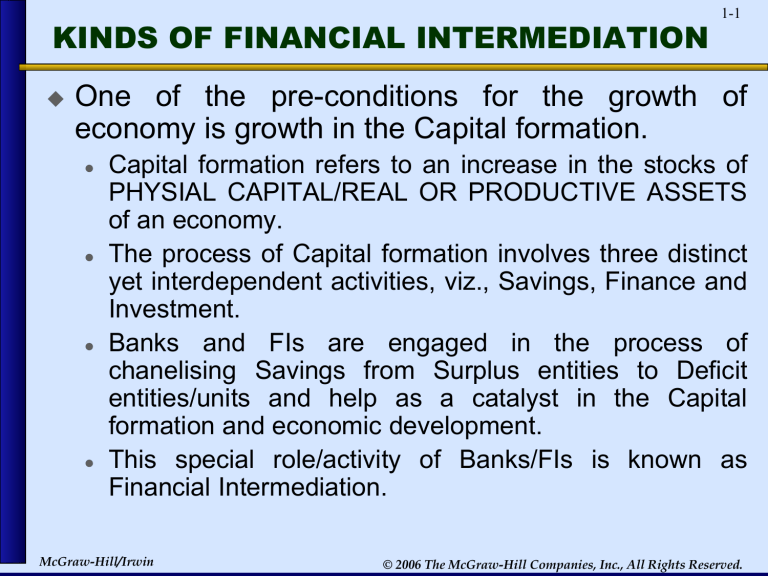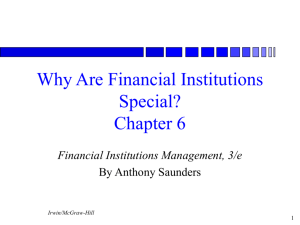Financial Intermediation: Capital Formation & Economic Growth
advertisement

KINDS OF FINANCIAL INTERMEDIATION 1-1 One of the pre-conditions for the growth of economy is growth in the Capital formation. Capital formation refers to an increase in the stocks of PHYSIAL CAPITAL/REAL OR PRODUCTIVE ASSETS of an economy. The process of Capital formation involves three distinct yet interdependent activities, viz., Savings, Finance and Investment. Banks and FIs are engaged in the process of chanelising Savings from Surplus entities to Deficit entities/units and help as a catalyst in the Capital formation and economic development. This special role/activity of Banks/FIs is known as Financial Intermediation. McGraw-Hill/Irwin © 2006 The McGraw-Hill Companies, Inc., All Rights Reserved. 1-2 Without FIs Equity & Debt Households Corporations (net savers) (net borrowers) Cash McGraw-Hill/Irwin © 2006 The McGraw-Hill Companies, Inc., All Rights Reserved. FIs’ Specialness 1-3 Without FIs: Low level of fund flows. Information and Monitoring costs : Very High Economies of scale reduce costs for FIs to screen and monitor borrowers Less liquidity Maturity Mismatch Substantial price risk High Default Risk/ Credit Risk McGraw-Hill/Irwin © 2006 The McGraw-Hill Companies, Inc., All Rights Reserved. 1-4 With FIs FI Households Cash (Brokers) FI Corporations Equity & Debt (Asset Transformers) Deposits/Insurance Policies McGraw-Hill/Irwin Cash © 2006 The McGraw-Hill Companies, Inc., All Rights Reserved. 1-5 KINDS OF FINANCIAL INTERMEDIATION Banks and FIs actually performs various kinds of intermediation functions/ transformation services. They are: Denomination (or Quantum) Intermediation Default-risk Intermediation Maturity Intermediation Liquidity Intermediation McGraw-Hill/Irwin © 2006 The McGraw-Hill Companies, Inc., All Rights Reserved. KINDS OF FINANCIAL INTERMEDIATION Contd… 1-6 Information Intermediation Time Intermediation Risk Pooling and Diversification (Economies of Scale & Economies of Scope) Risk Sharing & Asset Transformation McGraw-Hill/Irwin © 2006 The McGraw-Hill Companies, Inc., All Rights Reserved. 1-7 Kinds of Financial Intermediation Contd …. Denomination (or Quantum) Intermediation: is a kind that occurs when small amounts of savings from individuals and others are collected and pooled so as to give loans to others. This helps small savers to generate higher returns and lower risks on their portfolios. Default-risk Intermediation: refers to the willingness of FIs to make loans to risky borrowers and, at the same time, issue relatively safe and liquid securities in order to attract loanable funds from savers who are risk averse. Generally, the borrowers from an FI is perceived to be more risky than the FI itself. Thus FIs assumes the Default/Credit Risk onto itself and shield the Primary Savers. McGraw-Hill/Irwin © 2006 The McGraw-Hill Companies, Inc., All Rights Reserved. 1-8 Kinds of Financial Intermediation Contd… Maturity Intermediation: refers to the borrowing of relatively short-term funds from savers, who often cannot commit their funds over long periods, and making long-term loans to borrowers who require a long-term commitment to funds. Thus the FIs takes over the Maturity Mismatch Risk from the Primary Savers onto itself and thereby subject itself to consequent Interest Rate Risk. A Large FI is better able to bear the risk of mismatching of its assets and liabilities and manage the consequent Liquidity Risk and Interest Rate Risk through its superior access to markets and instruments for hedging the risks of such loans. McGraw-Hill/Irwin © 2006 The McGraw-Hill Companies, Inc., All Rights Reserved. Kinds of Financial Intermediation Contd…. 1-9 Liquidity Intermediation: refers to issuing of indirect claims to savers/depositors that are highly liquid while at the same time accepting relatively less liquid direct claims from borrowers/investors which may entail considerable risk of loss and high transaction costs if these claims are converted into cash. Thus FIs takes over the Liquidity & Price Risk from the Primary savers onto itself. McGraw-Hill/Irwin © 2006 The McGraw-Hill Companies, Inc., All Rights Reserved. 1-10 Kinds of Financial Intermediation Contd …. Information Intermediation: refers to the process by which FIs substitute their skill in gathering and processing information from financial market place for that of the savers who frequently have neither time nor expertise to stay abreast of the market developments nor access to relevant information about market conditions and investment opportunities. The FIs are perceived to possess “Asymmetric Information” which will facilitate in taking better decisions on the aspect of routing money to the investors/borrowers. Information Asymmetry is a situation in which one party to a transaction is better informed than the other. This is in fact one of the causes for existence of a Financial Intermediary. McGraw-Hill/Irwin © 2006 The McGraw-Hill Companies, Inc., All Rights Reserved. 1-11 Kinds of Financial Intermediation Contd …. Inter Generational wealth Transfer or Time Intermediation: refers to the process by which FIs, especially Life Insurance Companies and Pension Funds, provide savers with the ability to transfer wealth from their youth to old age across generations. This is of great importance to a country’s social well-being. For example, pension funds offer savings plans through which fund participants accumulate tax exempt savings during their working years before withdrawing them during their retirement years. By this act, FIs assumes on to itself the Longevity Risk (?) and other financial Risks from that of Primary Savers. McGraw-Hill/Irwin © 2006 The McGraw-Hill Companies, Inc., All Rights Reserved. Kinds of Financial Intermediation Contd …. 1-12 Risk Pooling & Diversification (Economies of Scale & Economies of Scope): FIs also engage in risk pooling and take advantage of Economies of Scale in their activities. Economies of scale refers to decreasing of costs of overall operation and performance by virtue of large size of operations. By deploying resources in loans and other assets like investments with a wide variety of risk-return characteristics, the benefits of financial diversification are achieved, enhancing the safety of funds supplied by savers. McGraw-Hill/Irwin © 2006 The McGraw-Hill Companies, Inc., All Rights Reserved. Kinds of Financial Intermediation Contd …. 1-13 Risk Pooling & Diversification (Economies of Scale & Economies of Scope): Most small savers cannot adequately diversify their limited funds among different types of investments. However, an FI can pool the funds of many small savers and efficiently diversify, achieving Economies of Scope, across many different investments, lowering risks of all savers. Economies of Scope refers to decreasing of costs of overall operation and performance as well as increasing the overall revenues by virtue of using/optimising the same existing resources including human resources (often underutilised) for various complementary and related operations. McGraw-Hill/Irwin © 2006 The McGraw-Hill Companies, Inc., All Rights Reserved. Kinds of Financial Intermediation Contd …. 1-14 Risk Sharing & Asset Transformation: Another benefit made possible by the low transaction costs of FIs is that they can help reduce the exposure of investors to risk—that is, uncertainty about the returns investors will earn on assets. FIs do this through the process known as risk sharing: They create and sell assets with risk characteristics that people are comfortable with, and the intermediaries then use the funds they acquire by selling these assets to purchase other assets that may have far more risk. Low transaction costs allow financial intermediaries to share risk at low cost, enabling them to earn a profit on the spread between the returns they earn on risky assets and the payments they make on the assets they have sold. McGraw-Hill/Irwin © 2006 The McGraw-Hill Companies, Inc., All Rights Reserved. Kinds of Financial Intermediation Contd …. 1-15 Risk Sharing & Asset Transformation: (Contd…) This process of risk sharing is also sometimes referred to as asset transformation or risk transformation because, in a sense, risky and illiquid assets (Primary securities like equity, debt securities, loans and mortgages) are turned into safer and liquid assets (Secondary securities like deposits and insurance policies) for investors. Hence FIs are called as Asset Transformers or Risk Transformers. McGraw-Hill/Irwin © 2006 The McGraw-Hill Companies, Inc., All Rights Reserved. Flow of Funds in a world with FIs : 1-16 Indirect Transfer/Financing Users of Funds Cash FI (Brokers) FI (Asset transformers) Financial Claims (Equity and debt securities, loans and mortgages etc.) PRIMARY SECURITIES McGraw-Hill/Irwin Suppliers of Funds 1-16 Cash Financial Claims (Deposits and insurance policies) SECONDARY SECURITIES © 2006 The McGraw-Hill Companies, Inc., All Rights Reserved. Risks incurred by FIs while performing1-17 the role of Financial Intermediation As Banks & FIs perform the various services described above, they assume many types of risks. Specifically, all FIs hold some assets that are potentially subject to default or credit risk (such as loans, stocks or bonds). Further, FIs tend to mismatch the maturities of their Balance Sheet Assets and Liabilities to a greater or lesser extents and are thus exposed to liquidity risk and interest rate risk. Moreover, all FIs are exposed to some degree of liability withdrawal or liquidity risk, depending on the type of claims they have sold to liability holders. McGraw-Hill/Irwin © 2006 The McGraw-Hill Companies, Inc., All Rights Reserved. Risks incurred by FIs while performing1-18 the role of Financial Intermediation Finally, all FIs are exposed to operating cost risk because the production of financial services requires the use of real resources and back-office support systems (labour and technology combined to provide services). Other risks FIs face include Off-Balance-Sheet risk, technology risk, country or sovereign risk and insolvency risk. We shall study all these risks in detail in the course on risk management in banking. McGraw-Hill/Irwin © 2006 The McGraw-Hill Companies, Inc., All Rights Reserved.



